Mountain biking at night transforms familiar trails into thrilling new adventures, and the key to unlocking this nocturnal world is having the Top Mountain Bike Lights to pierce through the darkness. Whether you’re extending your ride beyond daylight hours, seeking the unique thrill of night riding, or preparing for a nighttime race, reliable and powerful bike lights are indispensable.
Our team of expert testers, comprising adventure racers, seasoned mountain bike coaches, and mechanical engineers, have dedicated years to riding with and evaluating mountain bike lights. We’ve rigorously tested over 30 different models, focusing on critical performance aspects such as brightness, beam patterns, form factor, ease of use, battery life, durability, and price.
From the outstanding Outbound Lighting Hangover helmet light and the versatile Trail Evo handlebar light, to the high-performance and premium Exposure Six-Pack Mk13, our recommendations cater to a spectrum of needs and budgets. If you’re navigating the choices and need guidance, explore our comprehensive buyer’s guide and price & value sections below, or quickly compare models in our comparison chart.
Editor’s Note: This guide was refreshed on October 18, 2024, to include our evaluations of new models for the fall and winter riding seasons. Recent additions include the Outbound Lighting Trail Evo and Hangover, the Exposure Six Pack Mk13 and Zenith Mk3, and the Knog Blinder X 1800 and 2300.
Best Overall Mountain Bike Helmet Light
Outbound Lighting Hangover
Check Price at Outbound Lighting
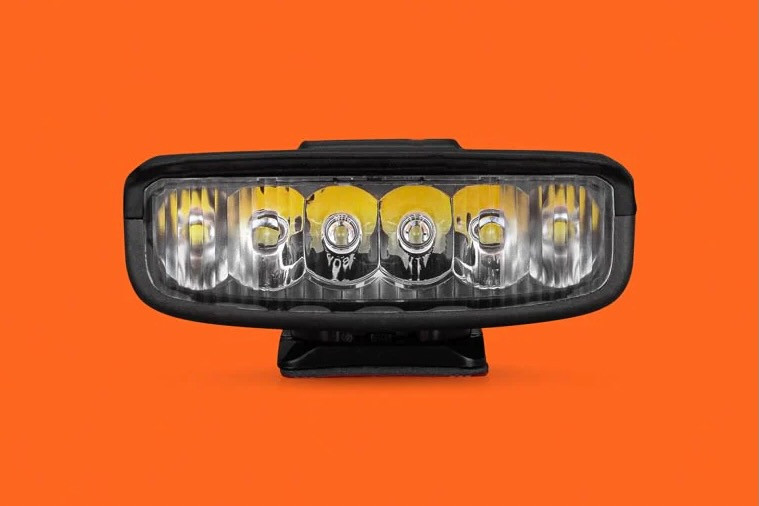 Outbound Lighting Hangover helmet light showcasing its compact design and mounting system
Outbound Lighting Hangover helmet light showcasing its compact design and mounting system
Key Specs:
- Type: Helmet
- Max Lumens: ≈ 1000
- Battery: 3,500 mAh internal
- Burn Time: 1.1 hrs (high), 1.6 hrs (adaptive), 6.5 hrs (low)
- Weight: 108 g
- Mounts Included: Helmet (GoPro compatible)
Pros:
- Sleek and low-profile design
- Industry-leading helmet mounting system
- Wide and effective beam pattern
- Intuitive user interface (UX)
- Lightweight for helmet use
- Competitively priced
Cons:
- May be slightly underpowered for extremely high-speed night riding
- Not the absolute brightest or longest-lasting light
Tester Chelsey Magness highlights the Outbound Lighting Hangover ($135) as a standout helmet light, delivering approximately 1000 lumens from six LEDs in a remarkably lightweight 108g package. Available as a standalone unit or as part of the Evo Downhill package with the Trail Evo, the Hangover excels in trail illumination and ease of operation, making it a top recommendation for most riders.
Mounting the Hangover is exceptionally simple thanks to the included curved action camera mount, compatible with most helmets. Outbound Lighting also provides additional base options for unique helmet shapes, ensuring a secure fit. Its lightweight and low-profile design mean you’ll barely notice it during your ride.
User-friendliness extends to operation, with a large, raised single button that’s easy to locate and use, even with gloves. The indicator light clearly displays the current mode and remaining battery, a thoughtful touch that simplifies use compared to many other lights.
On the trail, the Hangover shines with its wide beam pattern, ideally suited for technical, medium-speed trails up to 20 mph. It eliminates tunnel vision, providing comprehensive visibility. While it might require slight angle adjustments for very fast, straight trails to maximize beam distance, its performance is exceptional for the vast majority of night riding scenarios.
Offering four modes—adaptive, high, medium, and low—with run times from 1:12 to 6:30 hours, the Hangover provides sufficient battery life for typical night rides of one to two hours. The adaptive mode intelligently adjusts brightness based on ambient light, conserving battery while maintaining consistent visual effectiveness as your eyes adjust to darkness. Conveniently, it can also be charged while riding via a USB-C connection.
The Outbound Lighting Hangover became our most frequently chosen helmet light during testing. Its wide, detail-rich beam and user-friendly design, combined with a competitive price, make it an excellent investment for serious night riders.
Best Overall Mountain Bike Handlebar Light
Outbound Lighting Trail Evo
Check Price at Outbound Lighting
Key Specs:
- Type: Handlebar
- Max Lumens: ≈ 2200
- Battery: 10,000 mAh internal
- Burn Time: 1.7 hrs (high), 2.6 hrs (adaptive), 8.5 hrs (low)
- Weight: 275 g (light), 42 g (mount)
- Mounts Included: Quick-release handlebar mount
Pros:
- Exceptionally well-designed handlebar clamp
- Wide and expansive beam pattern
- Excellent user experience
- Integrated internal battery
Cons:
- Beam reach may be limited at very high speeds
The Outbound Lighting Trail Evo ($245), the handlebar counterpart to the Hangover helmet light, delivers approximately 2200 lumens through nine LEDs, casting a wide and even beam across the trail. Available alone or in the Evo Downhill package with the Hangover, the Trail Evo mirrors its helmet-mounted sibling in providing outstanding visibility and user-friendliness, thanks to its internal battery, intuitive controls, and sturdy handlebar mount.
The handlebar mount is a standout feature, positioning the light centrally in front of the stem and incorporating cable management to prevent shadowing. Its pivoting clamp allows for easy attachment and removal, while maintaining a secure and low-profile setup.
The quick-release mechanism for detaching the light body is durable, user-friendly, and stable. Adjusting the light angle is tool-free and independent of the clamp, simplifying trail-side adjustments regardless of terrain pitch.
Similar to the Hangover, the Trail Evo excels in 95% of night riding scenarios. While its wide beam pattern might be outrun at extremely high speeds on straightaways, it provides ample power for most riding conditions, offering excellent visibility of trail features without causing eye fatigue or tunnel vision.
When paired with the Hangover helmet light as the Evo Downhill Package, the combination offers a superior user experience unmatched in the market today.
The Trail Evo offers the same modes as the Hangover: low, medium, high, and adaptive. Its 10,000 mAh internal battery delivers run times of 1:45 (high) to 2:35 (adaptive), allowing riders to confidently start their ride in high or adaptive mode and focus on the trail ahead.
For longer rides, switching to low mode for climbs and high or adaptive for descents efficiently manages battery life. The clear battery indicator further aids in battery management.
While the Exposure Six Pack Mk13 offers more raw power, the Trail Evo provides exceptional performance at less than half the price, making it a more practical choice for most night riders.
The Trail Evo’s exceptional user experience, wide and consistently bright beam, and streamlined mounting make it a top recommendation for anyone serious about investing in a high-quality mountain bike lighting system. The Evo Downhill package, combining the Trail Evo and Hangover, is particularly compelling for a complete lighting solution.
Best Budget Mountain Bike Helmet Light
Niterider Lumina Pro 1200
Check Price at Performance Bike
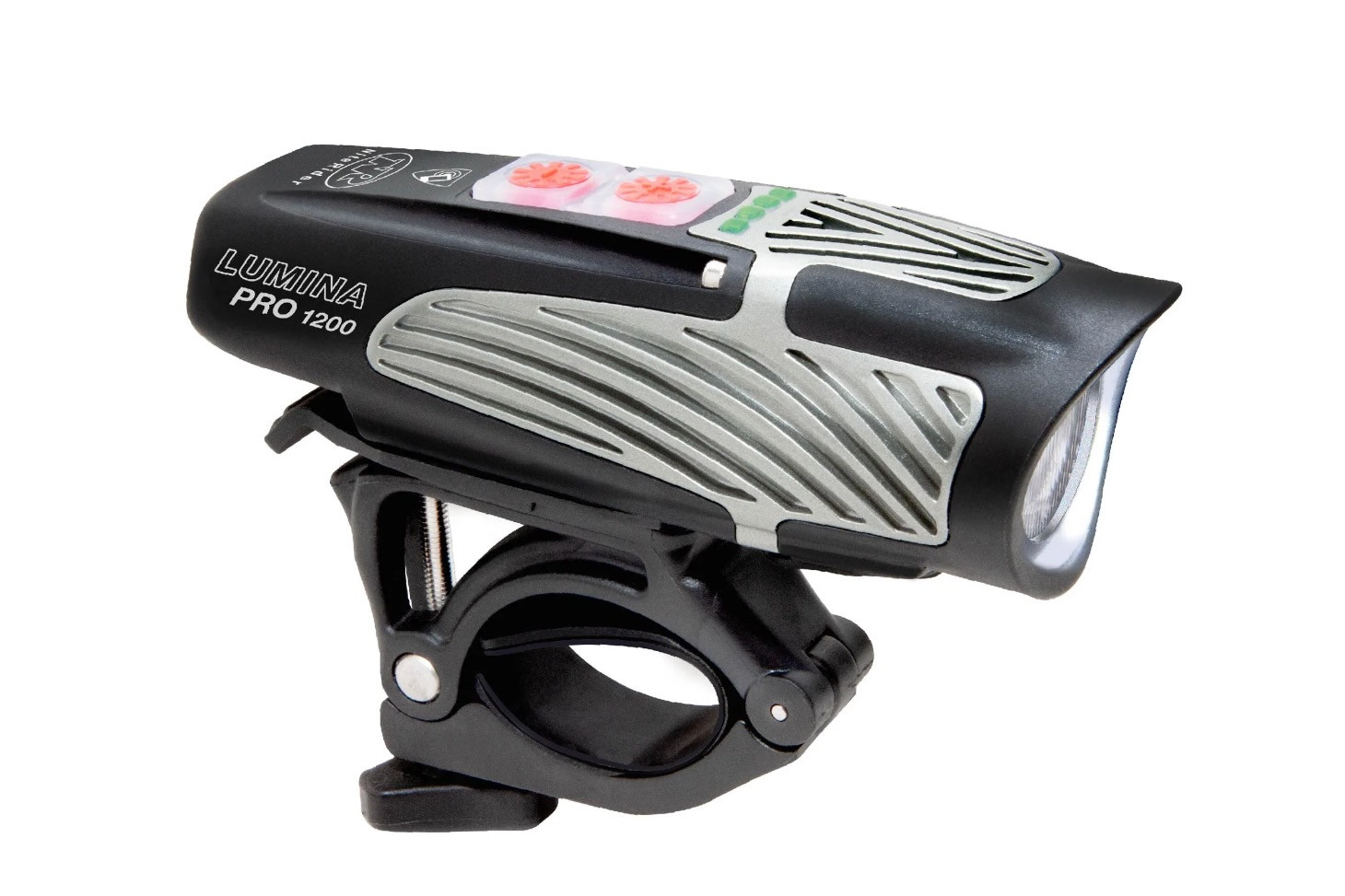 Niterider Lumina Pro 1200 helmet light showing its versatile handlebar and helmet mounting options
Niterider Lumina Pro 1200 helmet light showing its versatile handlebar and helmet mounting options
Key Specs:
- Type: Helmet or Handlebar
- Max Lumens: 1200
- Battery: Internal (unspecified capacity)
- Burn Time: 55 min (high), 7 hrs (low)
- Weight: 193 g
- Mounts Included: Handlebar (Helmet mount sold separately)
Pros:
- Affordable price point
- Simple and intuitive operation
- Stable, tool-free handlebar mount included
- Versatile for both handlebar and helmet use
Cons:
- Shorter battery life in Boost Mode
- Slightly heavier for helmet mounting compared to premium options
The Niterider Lumina Pro 1200 ($115) is a 1,200-lumen light offering dual functionality as both a handlebar and helmet light. The handlebar mount is included, while the helmet mount is available separately. Featuring colored LEDs to indicate battery life and mode, simple two-button operation, and secure mounting options, it stands out for its versatility and value.
The Lumina Pro 1200 includes a travel lock mode, preventing accidental battery drain during transport. Setup is straightforward; unlocking the light is the only initial step. Two buttons and indicator lights make mode selection and battery monitoring easy. The tool-free handlebar mount is quick to set up, and a full charge is achieved in just over 4 hours.
It offers five steady output modes ranging from Walk (65 lumens for 20 hours) to Boost (1200 lumens for 55 minutes), plus three pulse modes with 8-hour battery life. The two-button design allows for easy toggling between settings, including direct access between High and Medium modes, a user-friendly feature not always found in single-button lights.
On the trail, the Niterider Lumina Pro 1200 delivers reliable performance. While not as bright as premium options like the Exposure Zenith or Six Pack, and lacking the wide flood beam of Outbound Lighting models, it provides sufficient power for most night riding scenarios.
Boost mode, offering maximum brightness, has a shorter 55-minute battery life, requiring riders to manage usage, especially on longer descents. However, with strategic use of lower modes for climbs, battery life is sufficient for 1- to 3-hour rides, with the battery indicator providing reliable feedback.
The beam pattern is more focused, a spotlight style, compared to Exposure and Outbound Lighting, but offers competitive peripheral flood capability similar to lights like Lezyne Lite Drive 1200+ and Macro Drive 1400+. For aggressive trail riding, pairing the Lumina Pro 1200 as a helmet light with a wider beam handlebar light is recommended.
For handlebar use, while sufficient for winter fat biking and slower rides, a more powerful light might be preferred for faster summer trail riding. The helmet-mounted weight is noticeable but manageable.
At $115, the Niterider Lumina Pro 1200 is a versatile and budget-friendly choice, excellent for commuters who also want to explore occasional night trail rides. It’s a dependable, easy-to-use light that performs consistently for most moderate-paced trail riding.
Best Budget Mountain Bike Handlebar Light
Fenix BC30 Bike Light V2.0
 Fenix BC30 V2.0 handlebar light highlighting its compact design and wireless remote
Fenix BC30 V2.0 handlebar light highlighting its compact design and wireless remote
Key Specs:
- Type: Handlebar
- Max Lumens: 2200 (burst), 1500 (high)
- Battery: 2 x 18650 rechargeable Li-Ion batteries (not included)
- Burn Time: 2.3 hours (high)
- Weight: 154 g
- Mounts Included: Handlebar
Pros:
- Affordable price point
- High brightness for the price
- Replaceable batteries for extended rides
- Wireless handlebar remote control
Cons:
- Batteries need to be purchased separately
The Fenix BC30 V2.0 ($120) offers impressive features at an accessible price. Unique in this guide for using replaceable batteries (2×18650 or 4xCR123), it has been a reliable choice for expedition racers for years, including testers Chelsey and Jason Magness.
The V2.0 includes a wireless remote control, enhancing safety by allowing mode changes without removing hands from the handlebars on technical terrain. It offers five brightness settings from Eco (50 lumens) to High (1500 lumens), plus a Burst mode delivering a 2,200-lumen blast for 30 seconds—ideal for descents without significantly impacting overall burn time.
Run times are robust, offering up to 2.3 hours in High mode (1500 lumens) and 6 hours in Medium (600 lumens), suitable for typical 2-hour night rides. The option to use replaceable, readily available rechargeable batteries is a major advantage for extended trips, ensuring power for multiple nights of riding. However, this comes with a trade-off in waterproofness.
While rated IP67 for robust water protection when sealed, changing batteries in wet conditions requires caution to prevent water ingress into the battery compartment, which could lead to short circuits.
Another factor is that the BC30 V2.0 is sold without batteries, requiring an additional purchase. While this adds to the initial cost, the ability to carry spares and extend ride times is a significant benefit for longer adventures. For everyday rides, however, the simplicity of internal rechargeable batteries, like those in the Light & Motion Seca Comp 2000, might be preferred, despite the higher price point of such integrated systems.
Overall, the Fenix BC30 V2.0 stands out for its ease of use, brightness, and respectable run times, making it a strong handlebar mount option, or helmet light with an optional mount, that delivers excellent value without breaking the bank.
Best Premium Mountain Bike Helmet Light
Exposure Zenith Mk3
 Exposure Zenith Mk3 helmet light showcasing its machined finish and compact form factor
Exposure Zenith Mk3 helmet light showcasing its machined finish and compact form factor
Key Specs:
- Type: Helmet or Handlebar
- Max Lumens: 2200
- Battery: 5,000 mAh internal
- Burn Time: 1 hr (high), 18 hrs (low)
- Weight: 147 g (light), 11 g (mount)
- Mounts Included: Handlebar, Helmet, GoPro (adapter not included)
Pros:
- Exquisitely machined construction
- Powerful spotlight beam suitable for helmet use, yet wide enough when combined with handlebar lights
- Eight versatile modes
- Long beam throw, hard to outrun at high speeds
- Doubles as a high-quality flashlight
- Built for exceptional durability
- Premium packaging for secure storage
Cons:
- Included helmet clamp may not fit all helmet designs
- High price point
- Longer charge time
The Exposure Zenith Mk3 ($320) is a top-tier helmet light, though its premium price might be a barrier for some. It boasts a beautifully machined finish, a 2200-lumen max output, eight mode options, and a potent spot beam, making it ideal for serious night riders seeking top-end performance.
The Zenith Mk3’s helmet mount uses a unique vent clamp system that secures to the top and inside of the helmet shell, working well with most helmets. For helmets with incompatible vent designs, an action camera mount adapter can be purchased separately for $10, ensuring stable mounting. The inclusion of a lanyard enhances its utility as a powerful, everyday flashlight off the bike.
Initial setup is slightly more involved than simpler lights like the Outbound Lighting Hangover, but the range of modes justifies the initial setup effort. Features include TAP mode, which allows brightness adjustment by tapping the light body, useful for racing or frequent adjustments, though some testers preferred the standard button operation.
Mode options are extensive, with modes like Mode 1 (1 hour high, 3 hours medium, 6 hours low) and Mode 4 (1 hour high, 3 hours medium) fitting typical night ride durations. Battery life is ample for most rides, and the 3-hour medium setting is sufficient for climbs, with a 6-hour low setting available for extended use.
On the trail, the Zenith’s beam is more of a spotlight, ideal for a helmet light, especially when paired with a flood beam handlebar light like the Exposure Six Pack Mk13. This combination provides daytime-level visibility.
The Zenith’s 2200 lumens and long beam throw ensure you’ll never outrun the light. Its focused beam complements wider handlebar lights like the Outbound Trail Evo, offering a balanced lighting setup.
While the Outbound Hangover is our top overall helmet light recommendation due to its broad appeal, the Zenith Mk3 represents the pinnacle of helmet light performance for those prioritizing maximum capability and durability, justifying its higher cost for dedicated night riders.
Best Premium Mountain Bike Handlebar Light
Exposure Six Pack Mk13
Check Price at BackcountryCheck Price at Exposure Lights
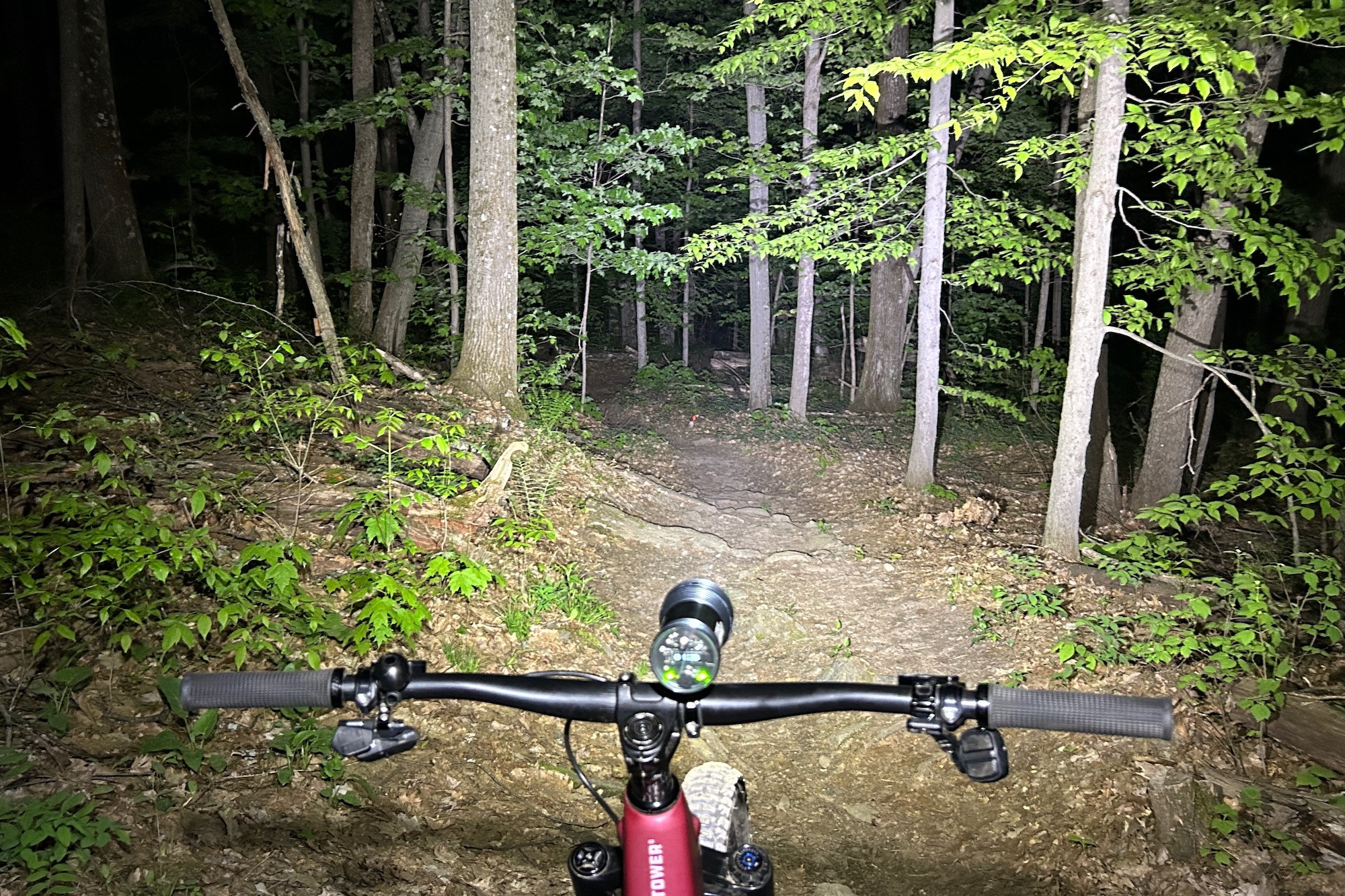 Exposure Six Pack Mk13 handlebar light highlighting its robust clamp and LCD screen
Exposure Six Pack Mk13 handlebar light highlighting its robust clamp and LCD screen
Key Specs:
- Type: Handlebar
- Max Lumens: 5450 (Reflex++), 3900 (constant)
- Battery: 17,000 mAh internal
- Burn Time: 2 hrs (high), 36 hrs (low), 3 hrs (Reflex++)
- Weight: 404 g (light), 27 g (mount)
- Mounts Included: Handlebar
Pros:
- Reflex++ mode for intelligent brightness adjustment
- Beautifully machined construction
- Built for exceptional durability
- Extremely bright output
- Wide and expansive beam pattern
- Premium packaging for secure storage
Cons:
- High price point
- Heavier weight compared to other lights
The Exposure Six Pack Mk13 ($536) is a powerhouse mountain bike light, boasting 3900 lumens of constant output (up to 5450 lumens in Reflex++ mode), ten brightness settings, and a durable, low-profile mount. It’s our top pick for serious night riders seeking a robust, user-friendly, and exceptionally bright light. Its machined construction ensures long-lasting performance.
An LCD screen displays the selected program, setting, and remaining battery life, simplifying setup and trail-side adjustments. Mode settings are printed on the light body, and the LCD screen makes selection easier than counting flashes on other models. Ten modes offer a wide range of options, with Mode 1, 4, and 7 being frequently used during testing, and a total range from 2 hours on high to 36 hours on low.
The 17,000 mAh battery provides a minimum 2-hour burn time on high (3900 lumens) and up to 36 hours on low, catering to diverse riding needs. Mode 1 with Reflex++ technology automatically adjusts brightness based on riding conditions, eliminating manual adjustments for rides under 3 hours.
Reflex++ technology utilizes 3D digital accelerometers, gyroscopes, and thermistors to intelligently adjust brightness. It learns rider style over 20 minutes and continuously adapts to optimize output based on speed and terrain.
In Mode 1, Reflex++ maximizes runtime to 3 hours while delivering up to 5450 lumens for fast descents. It reliably provides optimal brightness automatically, dimming on climbs and brightening on descents.
The Six Pack Mk13 provides superior visibility compared to any other light tested, making it ideal for aggressive night riding. Its wide beam pattern illuminates both the trail and periphery, with a long throw that eliminates any chance of outrunning the light. While heavier at 404 grams, the sturdy handlebar clamp ensures stable and quiet performance.
Despite its high $536 price, the Exposure Six Pack Mk13 is a long-term investment in top-tier performance and durability. For dedicated night riders, its exceptional brightness, Reflex++ technology, balanced beam pattern, and robust build quality justify the cost, making it the ultimate mountain bike light.
Best of the Rest
Knog Blinder X 1800
$375 at AmazonCheck Price at Knog
Key Specs:
- Type: Handlebar or Helmet
- Max Lumens: 1800
- Battery: 10,000 mAh external
- Burn Time: 2.5 hrs (high), 6.5 hrs (med), 15 hrs (low)
- Weight: 153 g (light/mount), 280 g (battery)
- Mounts Included: Handlebar, Helmet, Battery mounts
Pros:
- Includes both helmet and handlebar mounts
- Wired handlebar remote control
- High brightness output
- Excellent beam throw and spread
- Long run times
Cons:
- External battery pack adds complexity
- Heavier system weight
- Helmet mount may not be universally compatible
Knog, known for commuter lights, enters the off-road market with the Blinder X series, available in 1800 and 2300-lumen models. These lights offer impressive brightness, long run times, and a well-rounded design, though minor quirks prevent them from topping our overall rankings.
Both models share identical form factors and included accessories: a 10,000 mAh external battery pack with frame and bottle cage mounts, handlebar mount (with shims for 31.8 and 35 mm bars), strap helmet mount, remote mount, and a 700 mm extension cable.
With both handlebar and helmet mounts included, testers used the 2300 on handlebars and the 1800 on a helmet. The handlebar mount is a stable hinged clamp, while the helmet mount uses Velcro straps through helmet vents, proving surprisingly stable, though potential compatibility issues exist depending on helmet vent configuration. Angle adjustments require tools for both mounts.
Battery pack mounting offers frame or bottle cage options. Frame mounting, avoiding cable extension, proved stable. Helmet mounting used the extension cable with the battery stashed in cargo bib pockets, functional but slightly cumbersome like any external battery system.
The wired remote easily mounts to handlebars and helmets with magnetic straps or stick-on mounts. It toggles through light modes and indicates brightness settings, while the battery power button shows remaining charge.
Blinder X lights are exceptionally bright with a focused beam and excellent peripheral spread, providing daylight-level visibility on high mode. A remote tap dims to medium, then low (350 lumens).
Run times are impressive, with the 1800 model offering 2.5 hours and the 2300 model 1.8 hours on high, and triple that on medium.
The Blinder X series is a strong contender for serious night riders. However, the external battery adds setup complexity compared to self-contained units. Angle adjustments require tools, and the combined light and battery system is heavier at 433g. Despite these minor drawbacks, these bright and well-performing lights are a valuable addition to the mountain bike light market.
Light & Motion Seca Comp 2000
 Light & Motion Seca Comp 2000 handlebar light showcasing its simple design and rubber strap mount
Light & Motion Seca Comp 2000 handlebar light showcasing its simple design and rubber strap mount
Key Specs:
- Type: Handlebar
- Max Lumens: 2000
- Battery: 28 Wh internal
- Burn Time: 1.5 hours (high), 6 hours (low)
- Weight: 221 g
- Mounts Included: Handlebar (GoPro compatible)
Pros:
- Simple operation and user interface
- Combination flood and spot beam
- Easy to attach and detach
- Sufficient brightness
Cons:
- Shorter burn time on high
- Rubber handlebar strap mount is less secure than clamp mounts
The Light & Motion Seca Comp 2000 ($230) offers a refreshing simplicity compared to more complex, feature-rich models. It’s a straightforward package: light, handlebar mount, and charging cord.
This self-contained unit is intuitive and bright, delivering 2,000 lumens. Its beam pattern is well-designed, combining a spot beam for distance and a wide fill for periphery. With a 1.5-hour burn time on high, it suits most night rides, especially with mode switching. “Race Mode” simplifies toggling between medium and high settings with a single button press.
Versatile for trails and commuting, it includes daytime visibility modes and optional side lighting. The rubber strap mount is exceptionally easy to use, fitting any handlebar, and facilitates quick removal for charging or bike switching. However, the rubber strap is less secure on very rough terrain and raises long-term durability concerns compared to metal clamps.
Battery life is indicated by a tri-color power button. Full charge time is 4 hours via micro-USB.
The Seca Comp 2000 is ideal for riders who value simplicity and ease of use. It’s bright enough and user-friendly, making it an excellent entry point for night riding. Its versatility suits riders who commute and trail ride.
For serious night riding, the Outbound Trail Evo offers greater brightness and longer burn times. However, the Seca Comp 2000 remains a strong, simple option.
Lupine Lights Wilma R 7 Helmet Light System
Key Specs:
- Type: Helmet
- Max Lumens: 3600
- Battery: 6900 mAh external (compatible with other sizes)
- Burn Time: 1.45 hours (high)
- Weight: 122 g (light head only)
- Mounts Included: Helmet (extensive aftermarket options)
Pros:
- Highly modular with extensive compatibility across mounts and batteries
- Bluetooth control via app or remote
- Exceptionally bright output
- Excellent beam throw and spread
Cons:
- Very high price point
- External battery adds complexity
The Lupine Lights Wilma R 7 Light System ($650) is a high-tech, premium light system, comparable to a collaboration between Apple and Tesla in the bike light world – sleek, powerful, and expensive.
Lupine’s system is highly modular; batteries and lamp heads are universally compatible, and a vast array of accessories offers near-infinite configurations. However, initial setup and system building can be complex. Bar mounts, for example, require precise bar diameter matching. Once set up, the light system exudes quality and sophistication, fitting seamlessly on high-end bikes.
Lupine’s configurability is unmatched. Lamp heads can be used on helmets, handlebars, or even boats. Battery options range from large endurance packs to small emergency backups. Smartphone app control allows battery monitoring and brightness adjustments. The Wilma R 7 handles virtually any lighting need.
With a max output of 3600 lumens, it delivers daylight-level illumination, with a balanced beam throw and spread. Multiple customizable brightness settings cater to diverse preferences. The included 6,900 mAh battery provides 1.75 hours of runtime on high (3,600 lumens) and 3.3 hours at 1,800 lumens.
Drawbacks include the complexity of the external battery system, requiring wire management and battery mounting, and a very high $650 price. For the price, self-contained systems like the Exposure Six-Pack Mk13 or Zenith Mk3 might be more appealing in terms of simplicity.
However, the Wilma R 7 is a lifetime investment, offering unparalleled modularity and adaptability, making it a compelling option for users who need a highly customizable and expandable lighting system.
Light & Motion Vis Pro 1000 Trail
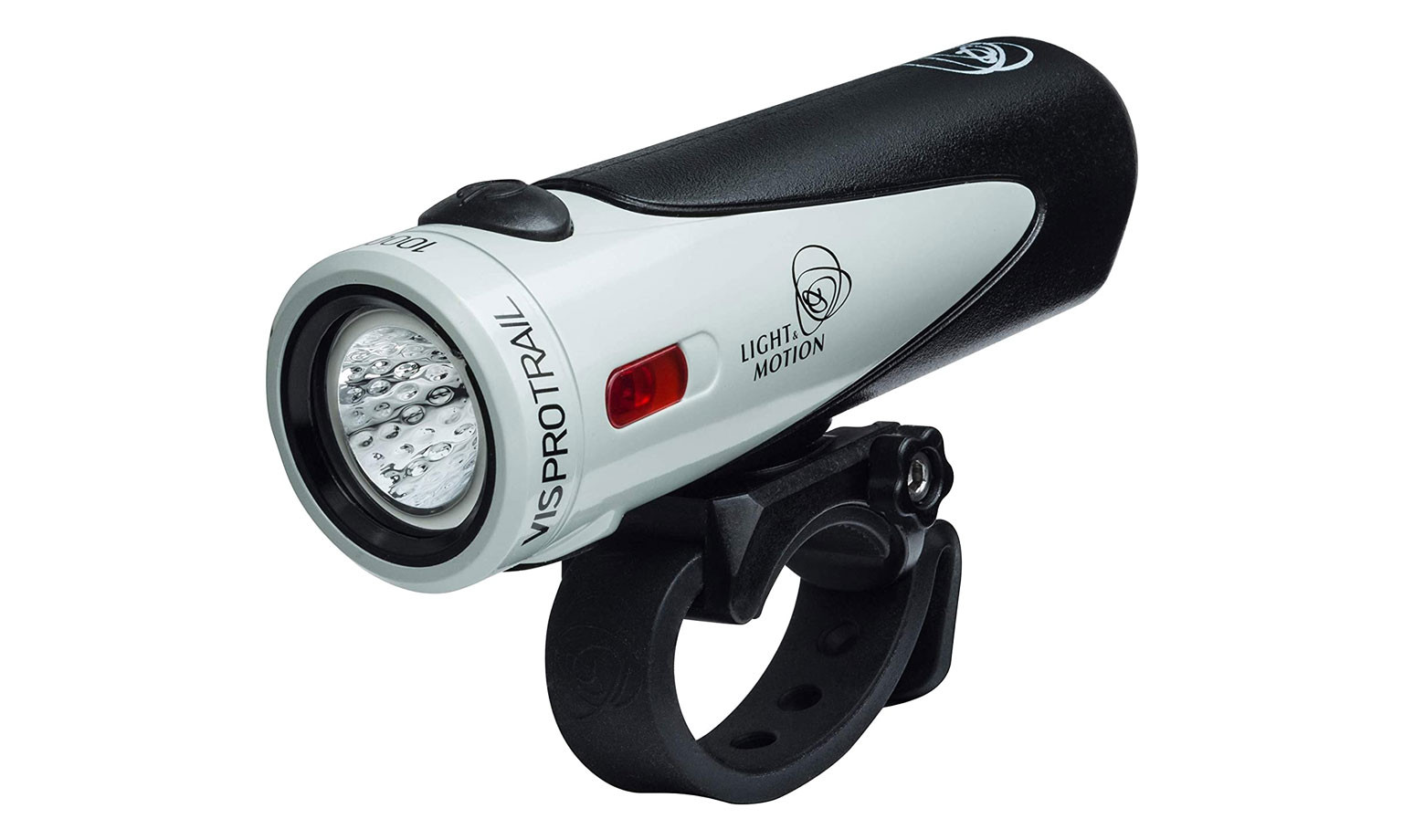 Light & Motion Vis Pro 1000 Trail handlebar light highlighting its compact and durable design
Light & Motion Vis Pro 1000 Trail handlebar light highlighting its compact and durable design
Key Specs:
- Type: Handlebar or Helmet
- Max Lumens: 1000
- Battery: Internal (unspecified capacity)
- Burn Time: 2.5 hours (high)
- Weight: 142 g
- Mounts Included: Handlebar, Helmet, GoPro
Pros:
- Lightweight and portable
- Durable and waterproof
- Can operate while charging
Cons:
- 1000 lumen max output is on the lower end for serious night riding
- Rubber mounting system is not the most stable on rough terrain
The Light & Motion Vis Pro 1000 Trail ($130), with 1,000 max lumens, is on the lower end for serious night riding. However, it’s ideal for bikepacking or emergency situations where light weight, portability, and reliability are prioritized over maximum brightness.
The Vis Pro 1000 excels in portability and durability. At 142g and waterproof to 1m, it’s barely noticeable and robust. Its self-contained design easily switches between handlebar and helmet use, even functioning as a headlamp. The strap mount allows quick attachment to any handlebar and easy removal.
Charging via USB takes 2.5 hours. It can operate at 150 lumens while charging, sufficient for extended gravel rides to camp. It runs for 1.5 hours on high and up to 6 hours on low (250 lumens), suitable for unexpected late finishes.
The beam pattern is less ideal for high-speed singletrack, and the rubber mount is not perfectly stable on very rough terrain. However, it’s an excellent light to pack for bikepacking or evening rides where darkness might unexpectedly fall.
Gloworm X2 Adventure Lightset
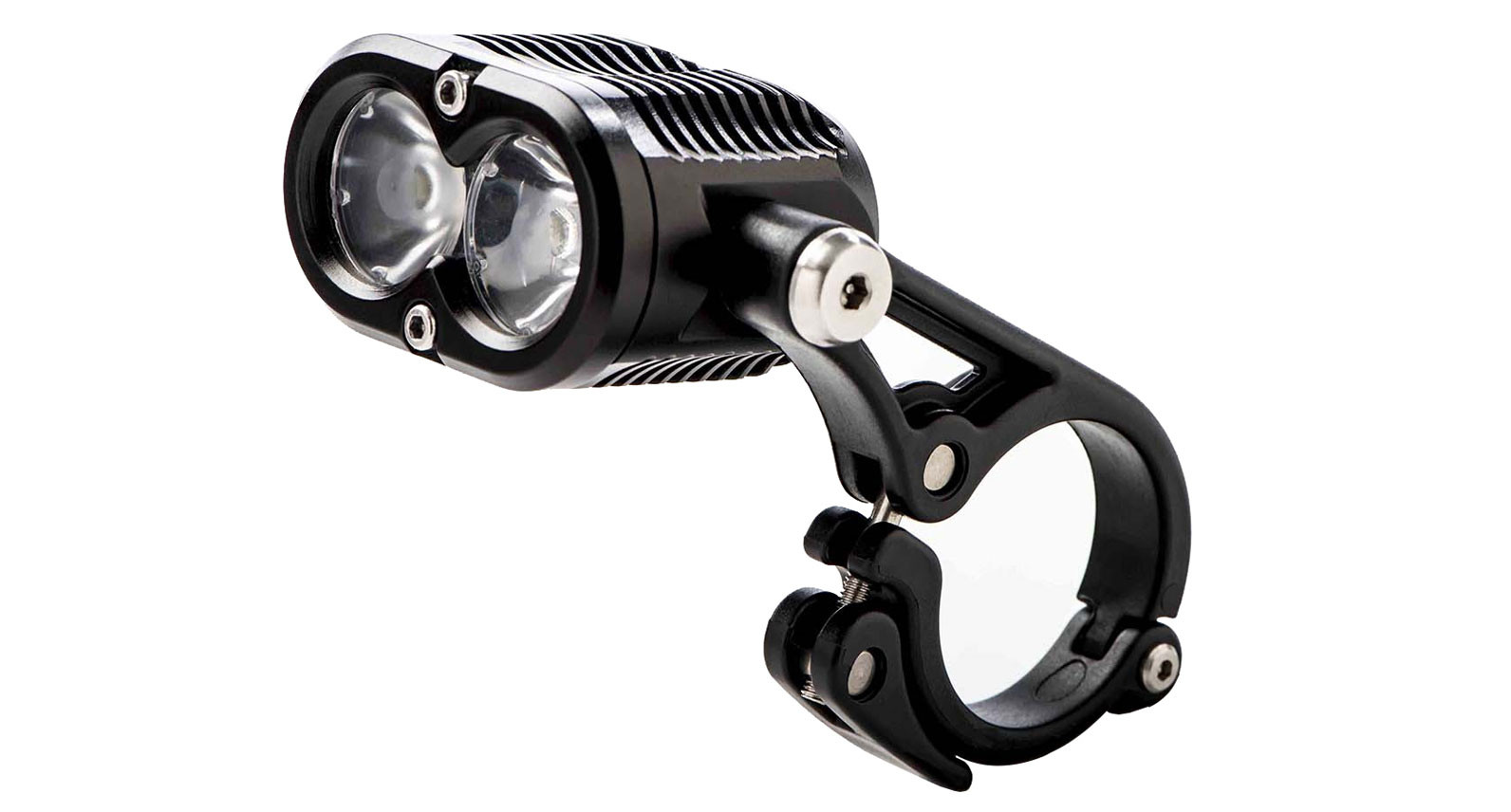 Gloworm X2 Adventure lightset showing its compact light head and external battery pack
Gloworm X2 Adventure lightset showing its compact light head and external battery pack
Key Specs:
- Type: Handlebar or helmet
- Max Lumens: 2000
- Battery: 5,000 mAh external
- Burn Time: 2 hours (high)
- Weight: 79 g (light head), 211 g (battery)
- Mounts Included: Handlebar, Helmet
Pros:
- Excellent value for the features
- Compact light head, minimal handlebar or helmet footprint
- Wireless remote control
- Interchangeable lenses for beam customization
- Customizable settings via Gloworm app
Cons:
- External battery adds complexity
- Heavier total system weight
The Gloworm X2 Adventure ($269), designed in New Zealand, offers exceptional value. It includes handlebar and helmet mounts, battery straps, and a Bluetooth remote.
The X2 Adventure is versatile and customizable. It includes mounts for handlebars, helmets (GoPro compatible), and headlamp straps. The light head is remarkably light at 79g, though it uses an external 211g battery pack.
Its 2,000-lumen output provides confidence at speed, and a 2-hour burn time on high is sufficient for most rides. Lower settings extend battery life for longer rides.
Gloworm’s LINK app allows extensive customization of brightness levels and burn times. It offers pre-programmed trail riding modes and a special flash mode for extended runtime.
A wireless remote enables on-the-fly brightness adjustments. Interchangeable lenses customize the beam pattern, and the battery pack doubles as a USB-C power bank.
The Gloworm X2 Adventure is highly capable and feature-rich, offering excellent value. However, like other external battery systems, it’s slightly less convenient than all-in-one units.
NiteRider Pro 4200 Enduro
Key Specs:
- Type: Handlebar
- Max Lumens: 4200
- Battery: 8-cell Li-Ion external
- Burn Time: 1.5 hours (high), 16.5 hours (600 lumens)
- Weight: 1406 g (total system)
- Mounts Included: Handlebar
Pros:
- Extremely bright 4,200 lumen output
- Long burn time at lower settings
Cons:
- High price point
- Heavy system weight
The NiteRider Pro 4200 Enduro ($450) is dubbed a “portable sun” for its intense 4,200-lumen output, designed for high-speed, long-duration, aggressive trail riding.
While lacking some of the refined beam patterns and programmability of other lights, its sheer usability for downhill speed at night is unmatched. The 4,200-lumen high beam is rarely needed, with lower settings providing ample light.
The Pro 4200 Enduro is more utilitarian than elegant, featuring a wired remote and a massive 8-cell battery pack providing up to 16.5 hours of burn time at 600 lumens. The universal handlebar mount fits 35mm bars.
Its high price and heavy 1406g weight are drawbacks, making it feel somewhat dated in battery technology. However, for riders prioritizing maximum brightness for extreme downhill or long burn times for 24-hour races, its weight might be acceptable. For a lighter and more affordable option, consider the Pro 2200 Race.
Mountain Bike Lights Comparison Chart
| Mountain Bike Light | MSRP | Lumens (max.) | Battery | Burn Time | Weight | Mounts |
|---|---|---|---|---|---|---|
| Outbound Lighting Hangover | $135 | ≈ 1000 | 3,500 mAh internal | 1.1 hrs. (high), 1.6 hrs. (adaptive), 6.5 hrs. (low) | 108 g | Helmet: GoPro (incl.) |
| Outbound Lighting Trail Evo | $245 | ≈ 2200 | 10,000 mAh internal | 1.7 hrs (high), 2.6 hrs. (adaptive), 8.5 hrs. (low) | 275 g (light), 42 g (mount) | Handlebar |
| Niterider Lumina Pro 1200 | $115 | 1200 | not specified | 55 min (high), 7 hrs. (low) | 193 g | Handlebar (incl.), Helmet (not incl.) |
| Fenix BC30 Bike Light V2.0 | $120 | 2200 (burst), 1500 (high) | 2 x 18650 rechargeable Li-Ion batteries (not incl.) | 2.3 hrs. (high) | 154 g | Handlebar |
| Exposure Zenith Mk3 | $320 | 2200 | 5,000 mAh internal | 1 hr. (high), 18 hrs. (low) | 147 g (light), 11 g (mount) | Handlebar, Helmet (incl.), GoPro (not incl.) |
| Exposure Six Pack Mk13 | $536 | 5450 (max Reflex++), 3900 (constant) | 17,000 mAh internal | 2 hrs. (high), 36 hrs. (low), 3 hrs. (Reflex++) | 404 g (light), 27 g (mount) | Handlebar |
| Knog Blinder X 1800 | $220 | 1800 | 10,000 mAh external | 2.5 hrs. (high), 6.5 hrs. (med), 15 hrs. (low) | 153 g (light/mount), 280 g (battery) | Handlebar, Helmet, Battery |
| Knog Blinder X 2300 | $270 | 2300 | 10,000 mAh external | 1.8 hrs. (high), 5 hrs. (med), 15 hrs. (low) | 153 g (light/mount), 280 g (battery) | Handlebar, Helmet, Battery |
| Light & Motion Seca Comp 2000 | $225 | 2000 | 28 Wh | 1.5 hrs. (high), 6 hrs. (low) | 221 g | Handlebar (works with GoPro, not incl.) |
| Lupine Lights Wilma R 7 Helmet Light System | $650 | 3600 | 6900 mAh | 1.45 hrs. (high) | 122 g (light head only) | Helmet |
| Light & Motion Vis Pro Trail 1000 | $100 | 1000 | not specified | 1.5 hrs. (high) | 142 g | Handlebar, Helmet, GoPro |
| Gloworm X2 Adventure | $269 | 2000 | 5,000 mAh | 2 hrs. (high) | 79 g (light), 211 g (battery) | Handlebar, Helmet |
| NiteRider Pro 4200 Enduro | $450 | 4200 | 8-cell Li-Ion | 1.5 hrs. (high) | 1,406 g (total system) | Handlebar |
Scroll right to see more product specifications.
How We Tested Mountain Bike Lights
The GearJunkie team has extensive experience in the saddle, with many staff members participating in after-work mountain bike rides and international adventure races. In adventure racing, reliable mountain bike lights are crucial for navigating through the dark, often determining success or failure. Our years of casual and competitive riding have honed our understanding of what constitutes the best lighting for night mountain biking.
Through numerous seasons of testing, we’ve recognized that lighting needs vary significantly—a downhill-focused light differs from one suited for all-night cross-country treks. We evaluated each light considering these diverse use cases, emphasizing real-world performance metrics like brightness, burn time, and weight. With continuous advancements in battery and LED technology, today’s MTB lights are constantly improving.
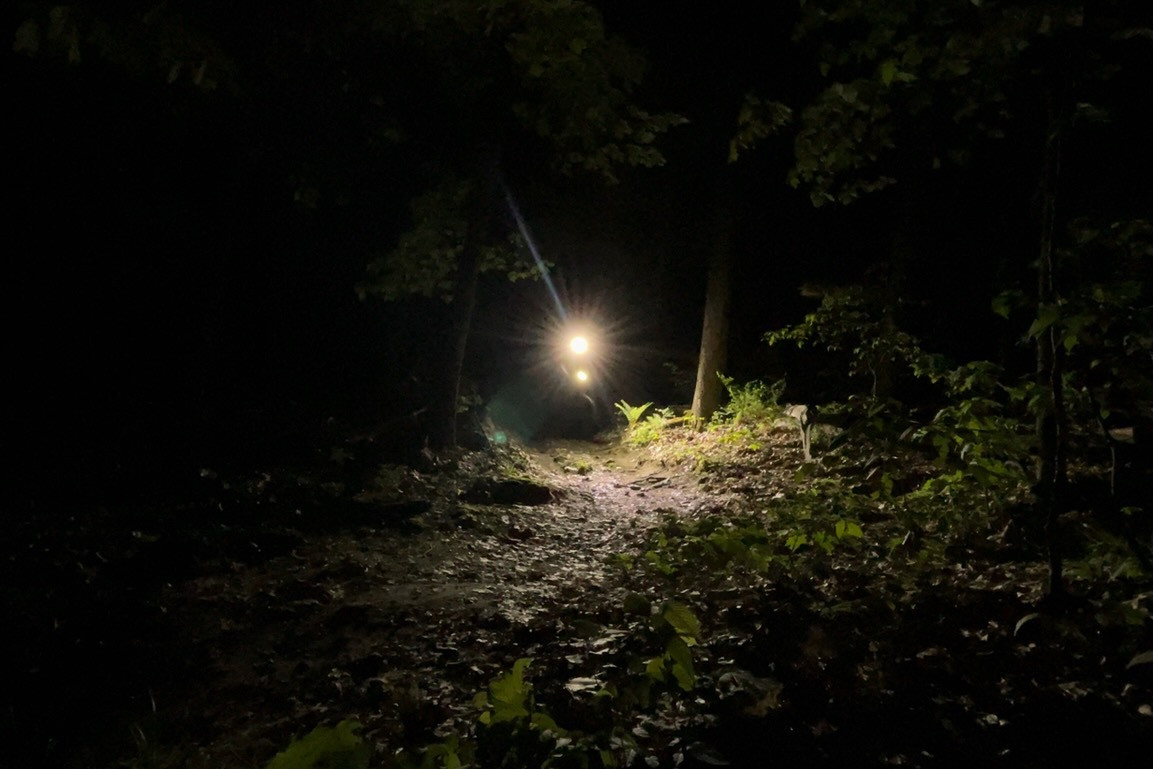 Tester riding at night to evaluate mountain bike lights beam pattern and brightness
Tester riding at night to evaluate mountain bike lights beam pattern and brightness
Our testing process involved extensive night riding with each mountain bike light to assess real-world performance. (Photo/Paul Clauss)
Our Expert Testers
Testers Chelsey and Jason Magness spearheaded this guide, initiating testing of 25 mountain bike lights in winter 2021. As professional adventure racers and Team GearJunkie members, the Magnesses have logged countless night riding hours, relying on bike lights for safe and efficient navigation during races.
Their deep understanding of mountain bike lights distinguishes the best from the rest. They incorporated feedback from fellow racers and friends to broaden testing perspectives.
GearJunkie contributor Paul Clauss further enriched this guide. A mechanical engineer, avid mountain biker, coach, and trail builder in Vermont, Paul regularly extends his rides into the night, using mountain bike lights on his trail and fat bikes for years.
Paul’s engineering background enables detailed analysis of design and its impact on functionality and user experience. His expertise extends to bike pumps, flat pedal mountain bike shoes, and flat pedals, enhancing our comprehensive gear reviews.
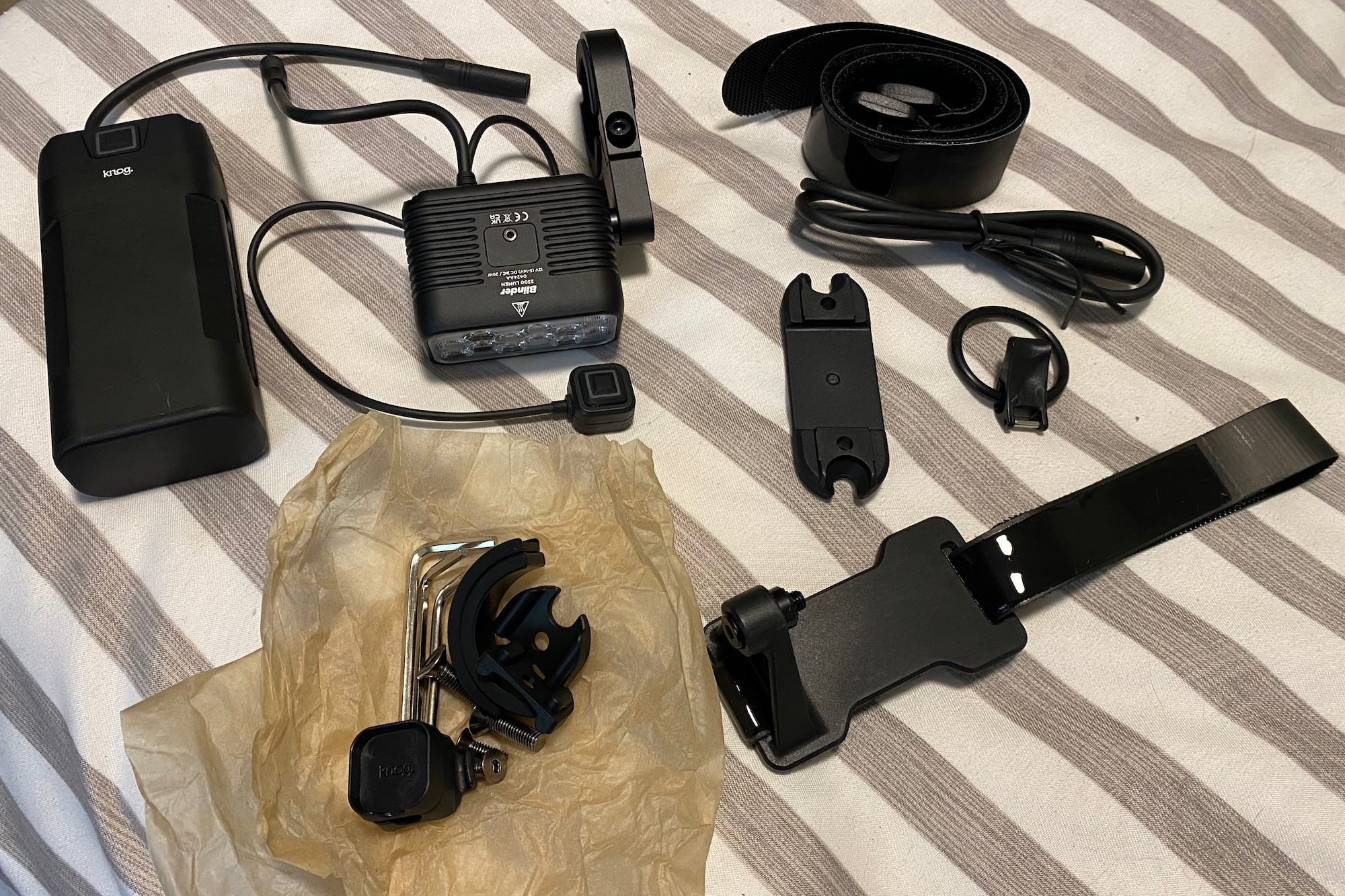 Components included with Knog Blinder X 1800 mountain bike light laid out for inspection
Components included with Knog Blinder X 1800 mountain bike light laid out for inspection
Initial steps in testing include familiarizing ourselves with each mountain bike light’s components, mounts, controls, and settings. (Photo/Jeremy Benson)
Our Testing Process
Our mountain bike light testing process begins with market research to identify leading models. We gather selected lights and subject them to rigorous real-world testing.
Initial steps include unboxing, inventorying parts, and assessing build quality. We weigh each light for consistency and compare to manufacturer specs. After charging, we mount each bike light to handlebars and helmets, evaluating ease of installation.
Mounted and adjusted, we test each model across numerous night rides, assessing brightness, beam throw, beam spread, settings, controls, stability, and ease of use. We switch between models for direct comparisons and utilize brand-specific apps for customization.
After months of testing, we consolidate notes to identify top performers and models excelling in specific areas. Many lights reviewed have been used by our team for years, attesting to their durability. We continuously test new lights to maintain an up-to-date and accurate best mountain bike lights guide.
Buyer’s Guide: How to Choose the Best Mountain Bike Lights
Selecting the right mountain biking light system involves considering several key factors. This guide covers essential variables to inform your decision.
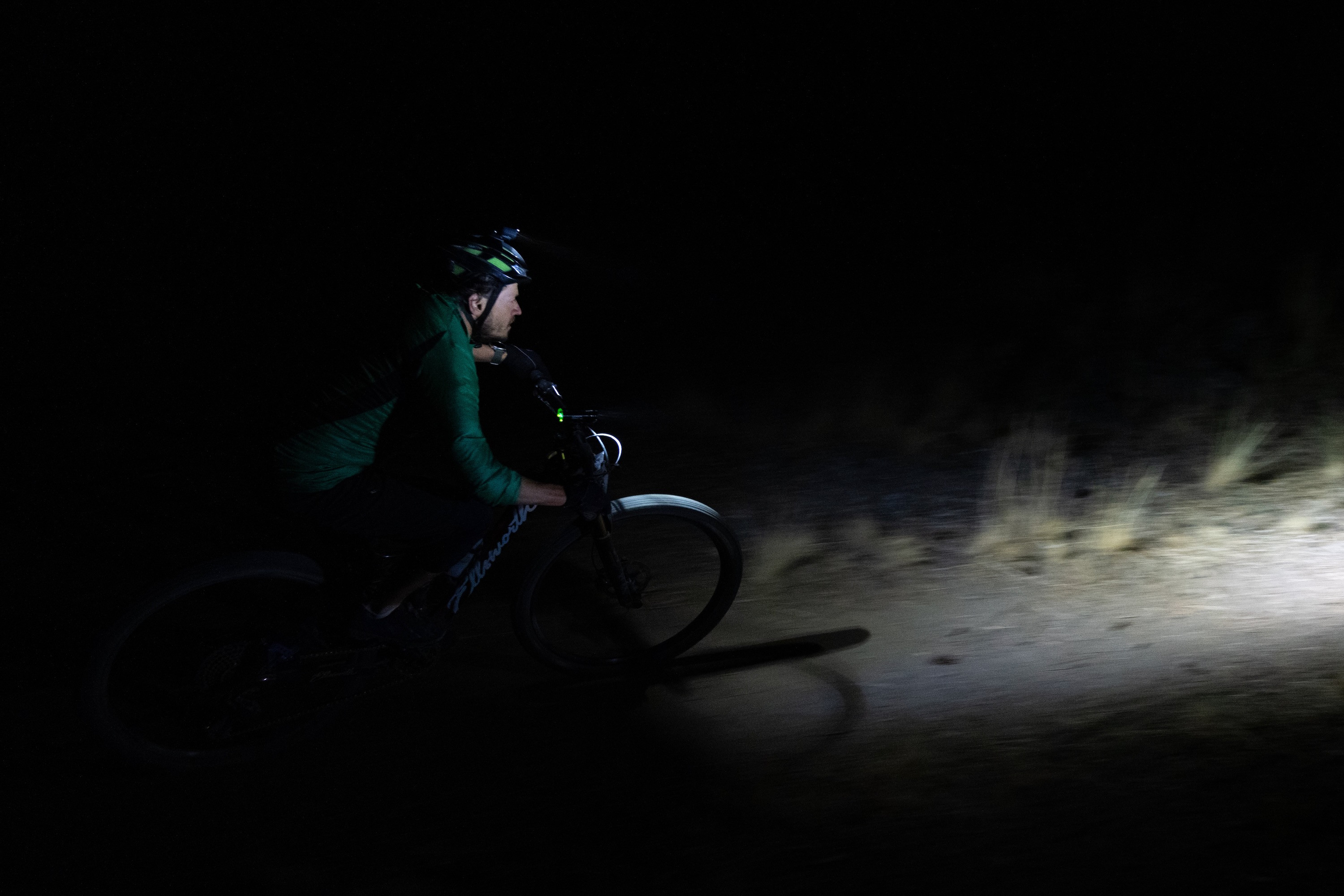 Mountain biker testing mountain bike lights at night to assess brightness and beam reach
Mountain biker testing mountain bike lights at night to assess brightness and beam reach
The type of night riding you plan to do will determine the necessary brightness of your mountain bike lights. (Photo/Darren Steinbach)
Types of Riding
Mountain bike lights vary as much as riding styles. Choose lights suited to your typical riding. This includes brightness, battery size, and form factor.
Faster, more technical riding demands brighter, more stable lights. Lower speeds and smoother terrain require less brightness, but adequate illumination is always necessary. We recommend using both helmet and handlebar lights for optimal visibility in all conditions.
Consider ride duration. Most lights suffice for typical couple-hour rides. For all-night riding, choose lights with extended run times. Winter snow riding often requires less brightness due to snow’s reflective properties.
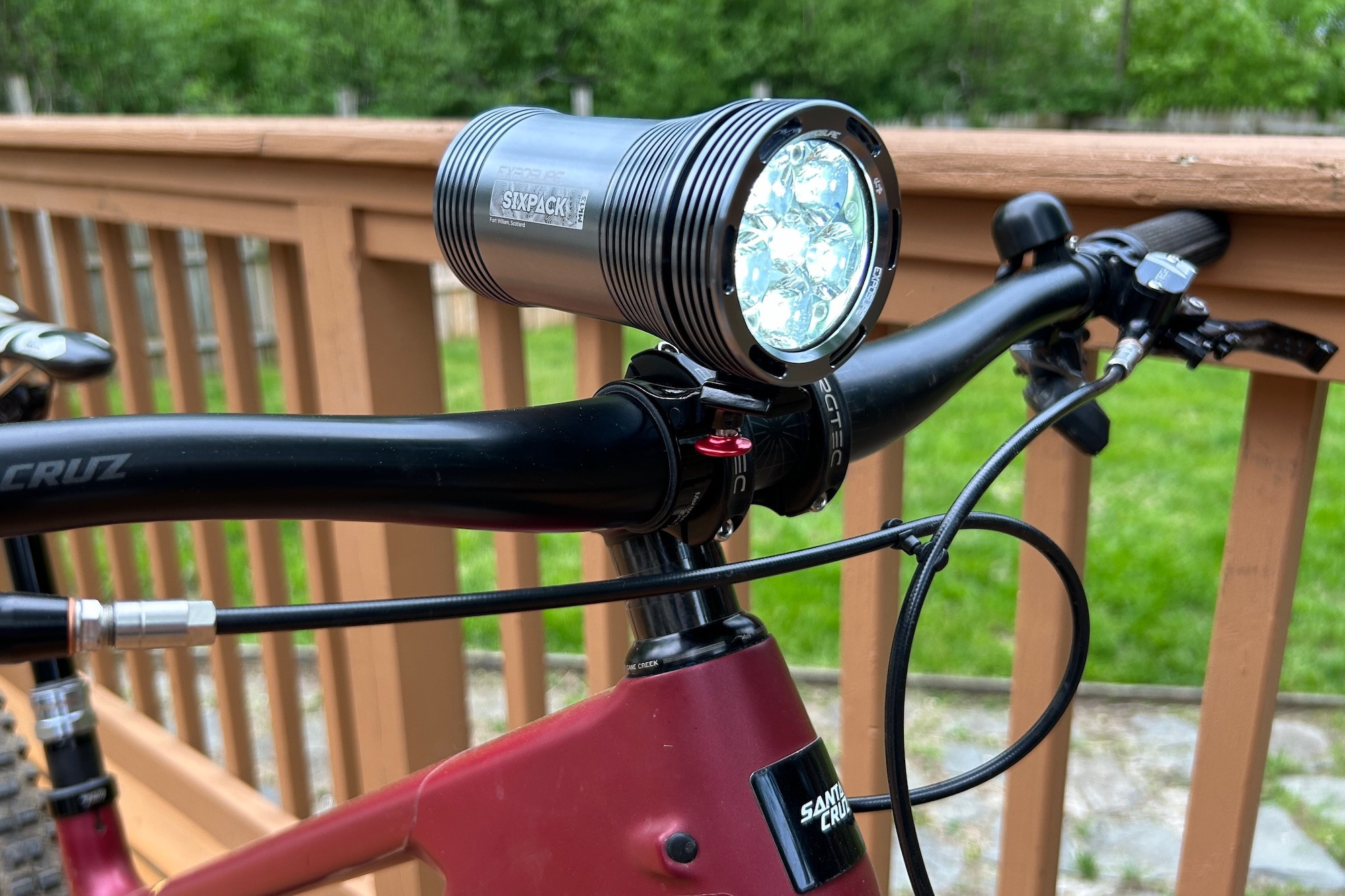 Exposure Six-Pack Mk13 mounted on handlebar showcasing its robust clamp and central positioning
Exposure Six-Pack Mk13 mounted on handlebar showcasing its robust clamp and central positioning
The Exposure Six-Pack Mk13 features a very sturdy handlebar clamp mount and delivers exceptional brightness. (Photo/Paul Clauss)
Helmet vs. Handlebar Mounts
Mountain bike lights mount on handlebars or helmets. A combination is ideal for night riding. While one or the other is usable, both offer superior visibility. Many lights come with one or both mounting systems, and aftermarket mounts allow location switching.
Handlebar lights point in your travel direction, moving with steering but not always directly where you look. Hinged clamp mounts, tightened with Allen keys, are most secure and stable, often with shims for 31.8mm and 35mm handlebars.
Lighter lights use stretchy rubber straps for tool-free, easy mounting, but are less secure than clamp mounts. Mount handlebar lights close to the stem for centered positioning.
Outbound Lighting’s Hangover helmet light securely attaches to a GoPro mount. (Photo/Paul Clauss)
Helmet lights move with your head, pointing where you look, and offer higher light source, casting light over obstacles. Essential for technical terrain, helmet lights enhance visibility in turns and varied landscapes.
Helmet mounts often use Velcro straps through helmet vents, or stick-on, clip-on, or action camera mounts.
Helmet light drawbacks include potential mount instability (especially strap types) and bounce during rides. Light weight on the head can require helmet tightening for stability. Most helmet lights are under 200g, minimizing weight impact.
Consideration of riding conditions, like snow, helps determine necessary mountain bike light brightness. Snow is forgiving for night riding, requiring less intense lighting. (Photo/Paul Clauss)
Brightness and Lumens
Brightness is measured in lumens. For low-light mountain biking, bright lights are crucial to illuminate the trail effectively.
For complete darkness, aim for minimum 500 lumens on both handlebar and helmet. For proper night riding, 1,000 lumens or more is recommended. Brighter lights improve visibility, speed, and safety in darkness.
Recent advancements have produced smaller, brighter mountain bike lights, some exceeding car headlight brightness, with 4,000+ lumens.
While extremely bright lights are sometimes overkill, a sweet spot around 2,000 lumens suits most riding scenarios without being excessive.
The Exposure Six-Pack Mk13 is among the brightest mountain bike lights, offering excellent beam spread and throw for confident riding at any speed. (Photo/Paul Clauss)
Most lights offer multiple brightness settings, allowing adjustment for terrain and speed. Full brightness is ideal for descents, while lower settings conserve battery on climbs or mellow terrain.
The Exposure Six Pack Mk13 is the brightest tested, reaching 5,450 lumens in Reflex++ mode and 3,900 lumens constant output. The Lupine Lights Wilma R 7 reaches 3,600 lumens, and the Niterider Pro 4200 Enduro hits 4,200 lumens, capable of daylight-like forest illumination.
The Niterider Lumina Pro 1200 provides good brightness but with a more focused, spotlight-style beam compared to the Exposure Six-Pack. (Photo/Paul Clauss)
Beam Pattern
Lumens alone don’t determine light performance; beam pattern and throw are crucial. Beam pattern describes light dispersal, ideally filling the trail with focused brightness where needed most.
Some lights feature spotlight beams, others floodlights. Balanced beams combine both. Many lights use multiple LEDs with varying beam characteristics.
Knog’s Blinder X 1800 and 2300 lights offer a well-balanced beam pattern, effectively illuminating trails for night riding. (Photo/Tucker Adams)
For example, Knog Blinder X models use 12 LEDs with a clear center for long throw and textured sides for wide spread. Gloworm X2 Adventure includes interchangeable lenses for beam pattern customization.
Beam throw, or distance, is important, especially at higher speeds. Brighter lights generally offer longer beam throw.
The Knog Blinder X 1800’s 10,000 mAh external battery supports 1,800 lumens for up to 2.5 hours, balancing brightness and battery life. (Photo/Jeremy Benson)
Ride Duration and Burn Time
Consider your typical ride duration when selecting mountain bike lights. Burn time is the duration a light operates before battery depletion, influenced by battery size and output level. Higher brightness consumes more battery power. Larger batteries offer longer run times.
Battery technology has improved, yielding more compact and lighter batteries. Combined with efficient LEDs, modern bike lights balance brightness, size, and weight better than ever.
The 10,000 mAh external batteries in Knog Blinder X models provide ample burn time for most night rides, balancing brightness and duration. (Photo/Tucker Adams)
Batteries are measured in Milliamp Hours (mAh); higher mAh indicates greater capacity. Brighter lights tend to have larger batteries, as battery capacity directly impacts burn time and weight.
The Exposure Six-Pack Mk13 has a 17,000 mAh battery, the largest tested, contributing to its size and 404g weight, yet still light for its capabilities.
Most tested lights run for 1.5-2 hours on high. Lower settings significantly extend battery life, suiting typical shorter night rides.
For 24-hour races, choose long-lasting lights like the Niterider Pro 4200 Enduro and use lower output settings, or plan for battery swaps or recharges.
 Outbound Lighting Trail Evo handlebar light, showing internal battery and clean design
Outbound Lighting Trail Evo handlebar light, showing internal battery and clean design
The Outbound Lighting Trail Evo handlebar light features an internal battery, creating a self-contained and user-friendly package. (Photo/Paul Clauss)
Internal vs. External Batteries
Mountain bike lights come with internal or external batteries. Self-contained units with internal batteries are generally simpler to use, though internal batteries may be smaller, leading to shorter burn times.
Internal battery lights can be heavier, especially as helmet lights. Batteries are typically non-swappable, requiring recharge after depletion.
Models like Exposure Zenith Mk3, Six-Pack Mk13, Outbound Lighting Hangover, Trail Evo, and Niterider Lumina Pro 1200 prioritize ease of use with internal batteries.
Many mountain bike lights, like the Knog Blinder X 1800 and 2300, use external batteries that attach to the bike frame or are carried in a pack, depending on light placement. (Photo/Jeremy Benson)
External battery lights separate the light head and battery, connected by a cord. This adds complexity with battery mounting to frame or pack, and cord management.
Advantages include lighter light heads for helmet use and larger, swappable battery packs for extended rides or races.
Top external battery lights include Knog Blinder X 1800 and Blinder X 2300, Lupine Lights Wilma R 7, and Gloworm X2 Adventure, all offering excellent performance despite the added complexity.
Ease of use varies among models, with some like the NiteRider Lumina Pro 1200 being very straightforward, while others are more complex in setup and operation. (Photo/Paul Clauss)
User Experience
Consider your willingness to program and customize your mountain bike light system. Some lights offer extensive customization, while others are plug-and-play.
Complex systems offer extensive features, while simpler lights prioritize ease of use. Self-contained lights with internal batteries are generally easier to manage than external battery systems.
Consider the time you’re willing to invest in setup and customization. Systems like Lupine offer vast upgradeability but might be overly complex for casual users.
While high-performance and customizable lights like the Exposure Six-Pack Mk13 are top-tier, simpler options like Outbound Lighting Hangover and Trail Evo offer excellent ease of use, brightness, and battery life for most riders at a lower cost, making them our overall top picks.
Mountain bike lights range widely in price. Investing in premium options like the Exposure Zenith Mk3 can be worthwhile for serious night riding enthusiasts. (Photo/Paul Clauss)
Price & Value
Mountain bike lights prices vary widely, from around $100 to $650. Higher prices often correlate with greater brightness, larger batteries, and advanced technology, but these features are not always necessary for every rider.
Budget
Avoid ultra-cheap lights; they often disappoint. For budget-conscious night riders seeking quality, aim for $100-$150 for brighter, longer-lasting, reliable lights.
Budget lights offer simplicity, 1,000-2,000 lumens brightness, smaller batteries, and ease of use, suitable for infrequent or shorter rides.
The Niterider Lumina Pro 1200 ($115) is a favorite budget option, versatile for handlebar or helmet use, delivering 1,200 lumens and user-friendliness.
The Outbound Lighting Hangover ($135) offers exceptional value with ease of use, compact form, light weight, and great beam spread, making it a top helmet light at any price.
Mid-Tier
Mid-tier mountain bike lights, priced $150-$300, offer increased brightness (2000+ lumens), larger batteries, and higher performance.
Outbound Lighting’s Trail Evo ($245) boasts 2,200 lumens, a stable handlebar mount, and a 10,000 mAh battery, combining ease of use and performance.
Knog’s Blinder X 1800 ($220) and Blinder X 2300 ($270) are also excellent mid-tier options, offering high brightness, stability, and long run times with external 10,000 mAh batteries, though the wired battery connection adds some complexity.
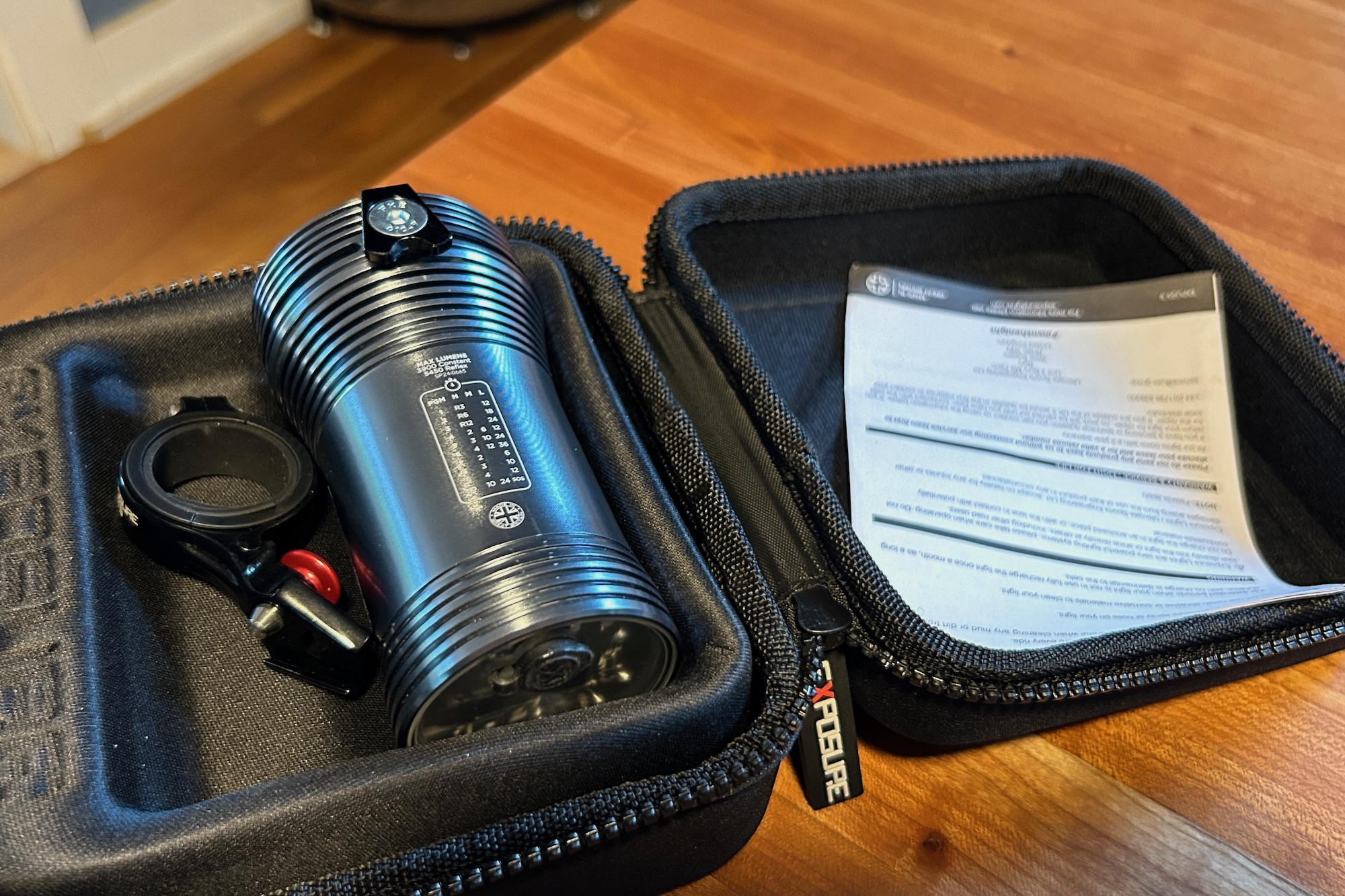 Exposure Six-Pack Mk13 storage case, highlighting premium packaging and light build quality
Exposure Six-Pack Mk13 storage case, highlighting premium packaging and light build quality
The Exposure Six-Pack Mk13 is expensive but exceptionally bright, technologically advanced, and boasts superior build quality, complemented by a premium storage case. (Photo/Paul Clauss)
Premium
Premium mountain bike lights, over $300, offer 2,000-4,000+ lumens, enhanced build quality, and advanced features like apps, touch sensitivity, and auto-adjusting brightness.
Exposure lights are top-tier premium performers. The Zenith Mk3 ($320) is a compact, 2,200-lumen helmet light under 150g with TAP technology and a sleek design.
The Six-Pack Mk13 ($536) offers 3,900 continuous lumens, Reflex++ auto-brightness, a 17,000 mAh battery, and premium build, representing the pinnacle of handlebar-mounted bike lights.
Frequently Asked Questions
Do I need lights on both my handlebars and my helmet?
While a helmet light alone is usable, we recommend both helmet and handlebar lights for optimal night riding visibility.
Helmet lights are crucial as they point where you look, invaluable on technical trails. Handlebar lights provide secondary illumination in your general travel direction. For best safety and visibility, use both.
Do I need mountain bike lights if I only ride during the day?
Even for daytime riders, carrying bike lights is wise for emergencies. Mechanical issues or extended rides can lead to unexpected darkness.
A light, even low-powered, can be crucial for safe navigation in unexpected darkness. Modern lights are compact and lightweight, making them easy to carry for preparedness.
How long do mountain bike lights last?
Mountain bike light battery life depends on battery size, brightness, settings, and temperature. High-quality lights at peak power typically last 90-150 minutes. Lower settings can extend run time two to threefold or more. High-capacity batteries can last up to 4 hours at full output.
Start rides fully charged and use lower brightness settings for climbs to conserve battery. Even with high lumen outputs, full power is not always necessary; reducing brightness extends battery life without compromising visibility in many situations.
How bright should my mountain bike lights be?
Mountain bike lights need to be brighter than road or commuter lights to illuminate trails effectively. Desired brightness depends on trail type and riding speed.
For faster or technical riding, brighter lights are better. For most riders, a 1,000-lumen helmet light and a 1,500-2,000 lumen handlebar light provide adequate illumination.
Adjust brightness based on riding speed to conserve battery. Even at reduced power, many lights still provide ample illumination for most situations.
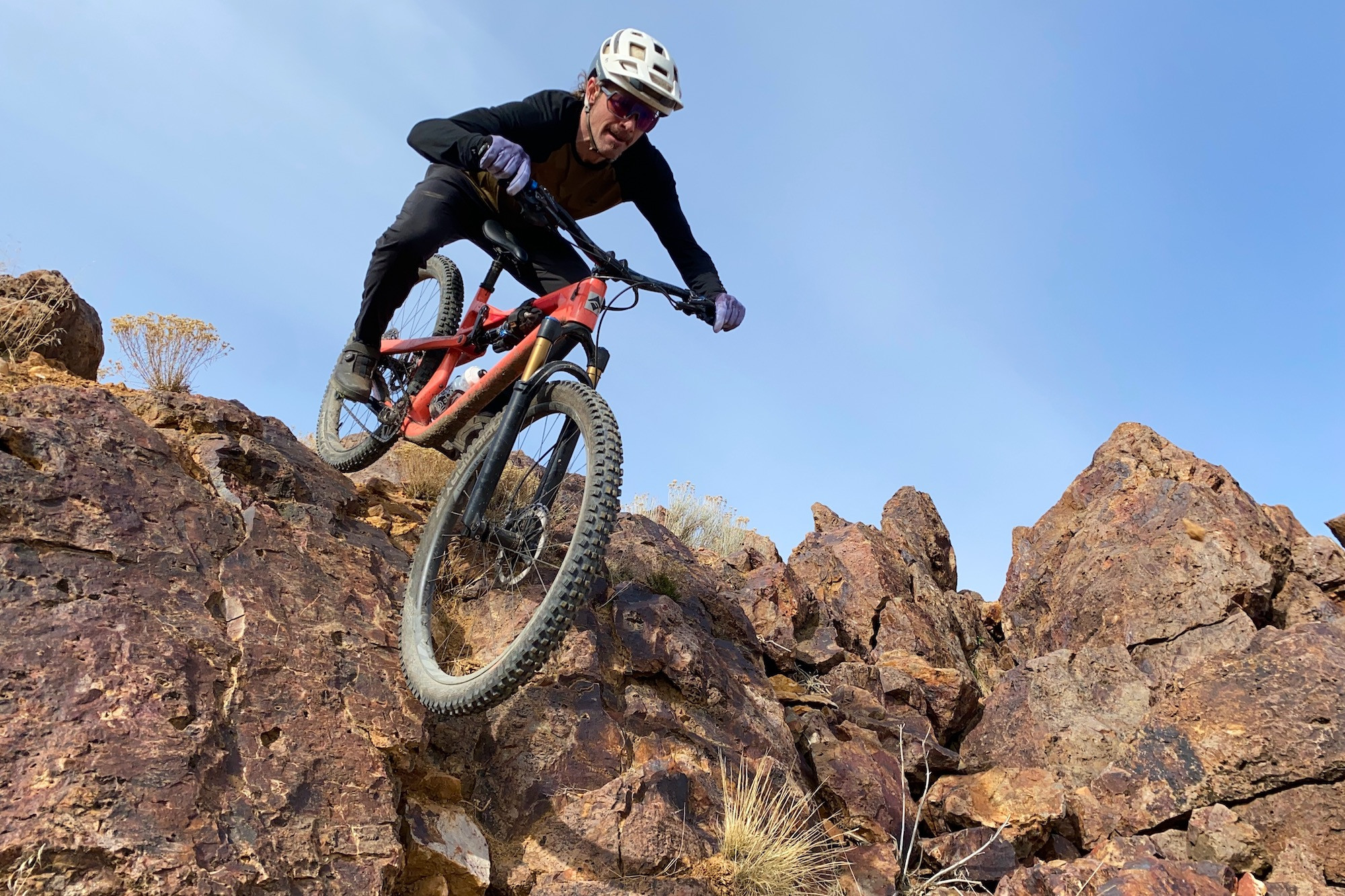 Best mountain bike helmets of 2024, linking to related article
Best mountain bike helmets of 2024, linking to related article
Biking
The Best Mountain Bike Helmets of 2024
Explore our top picks from Giro, Specialized, POC, Smith, and more to find your ideal mountain bike helmet.
 Best bike lights of 2025, linking to related article
Best bike lights of 2025, linking to related article
Biking
The Best Bike Lights of 2025
Discover the best bike lights for every need and budget from Knog, Fenix, Garmin, Lezyne, and more in our comprehensive guide.

 Knog Blinder X 1800 handlebar light with external battery and remote, showcasing its versatile mounting options
Knog Blinder X 1800 handlebar light with external battery and remote, showcasing its versatile mounting options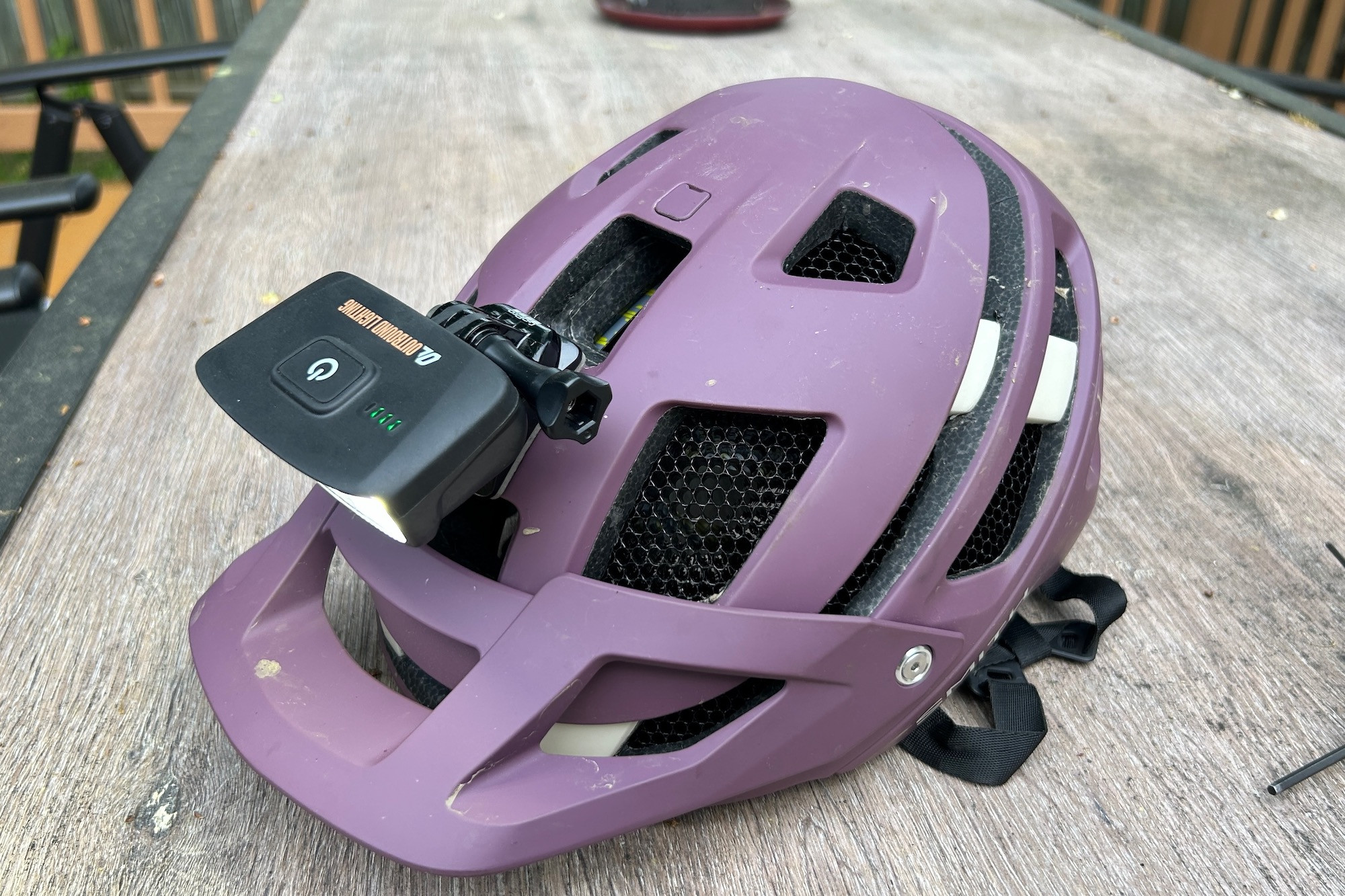 Outbound Lighting Hangover helmet light mounted using GoPro compatible mount, showing low profile design
Outbound Lighting Hangover helmet light mounted using GoPro compatible mount, showing low profile design Rider on fat bike in snow at night testing mountain bike lights, highlighting winter night riding conditions
Rider on fat bike in snow at night testing mountain bike lights, highlighting winter night riding conditions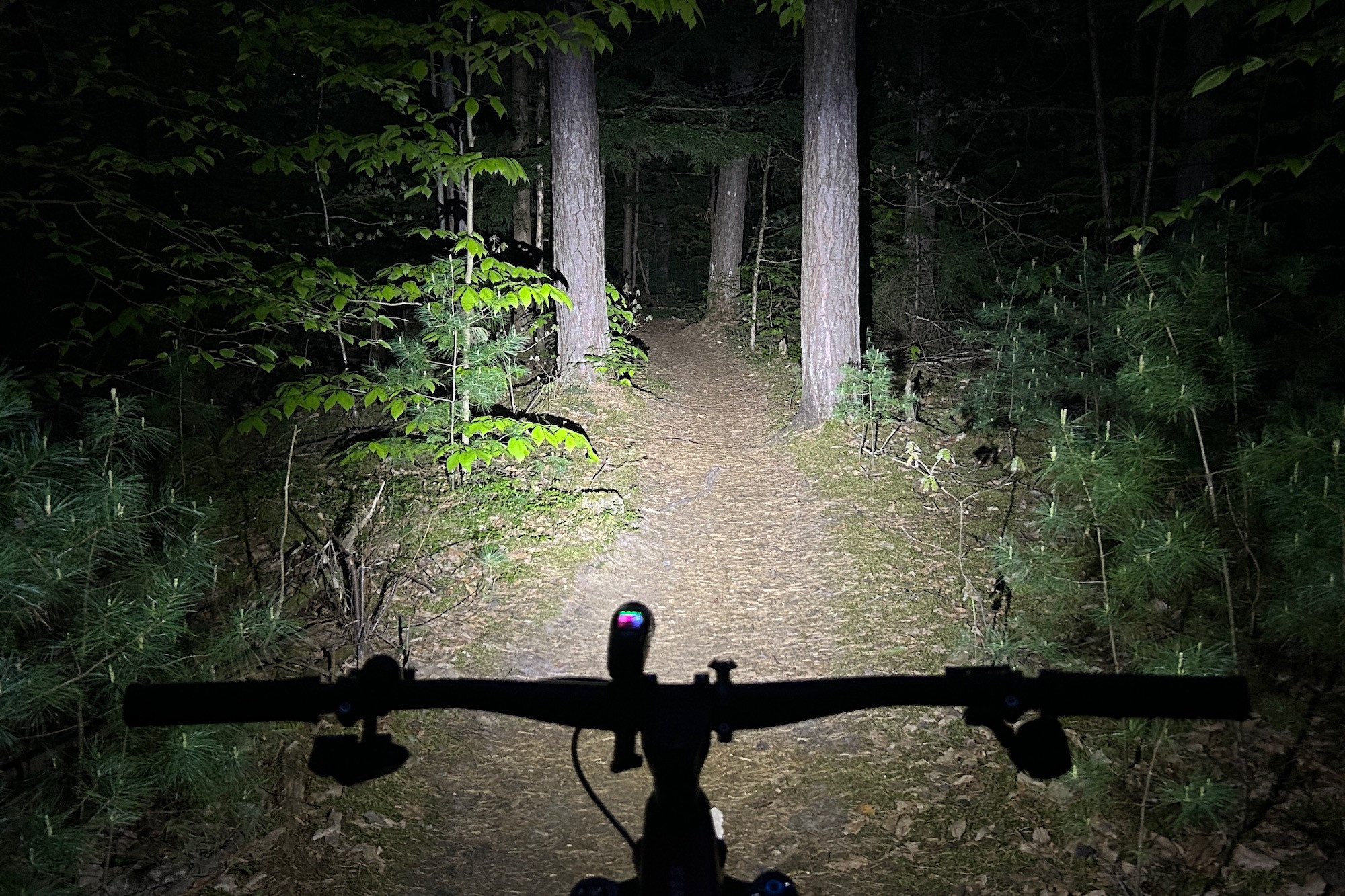 Niterider Lumina Pro 1200 beam pattern on trail at night, showing focused beam and good trail illumination
Niterider Lumina Pro 1200 beam pattern on trail at night, showing focused beam and good trail illumination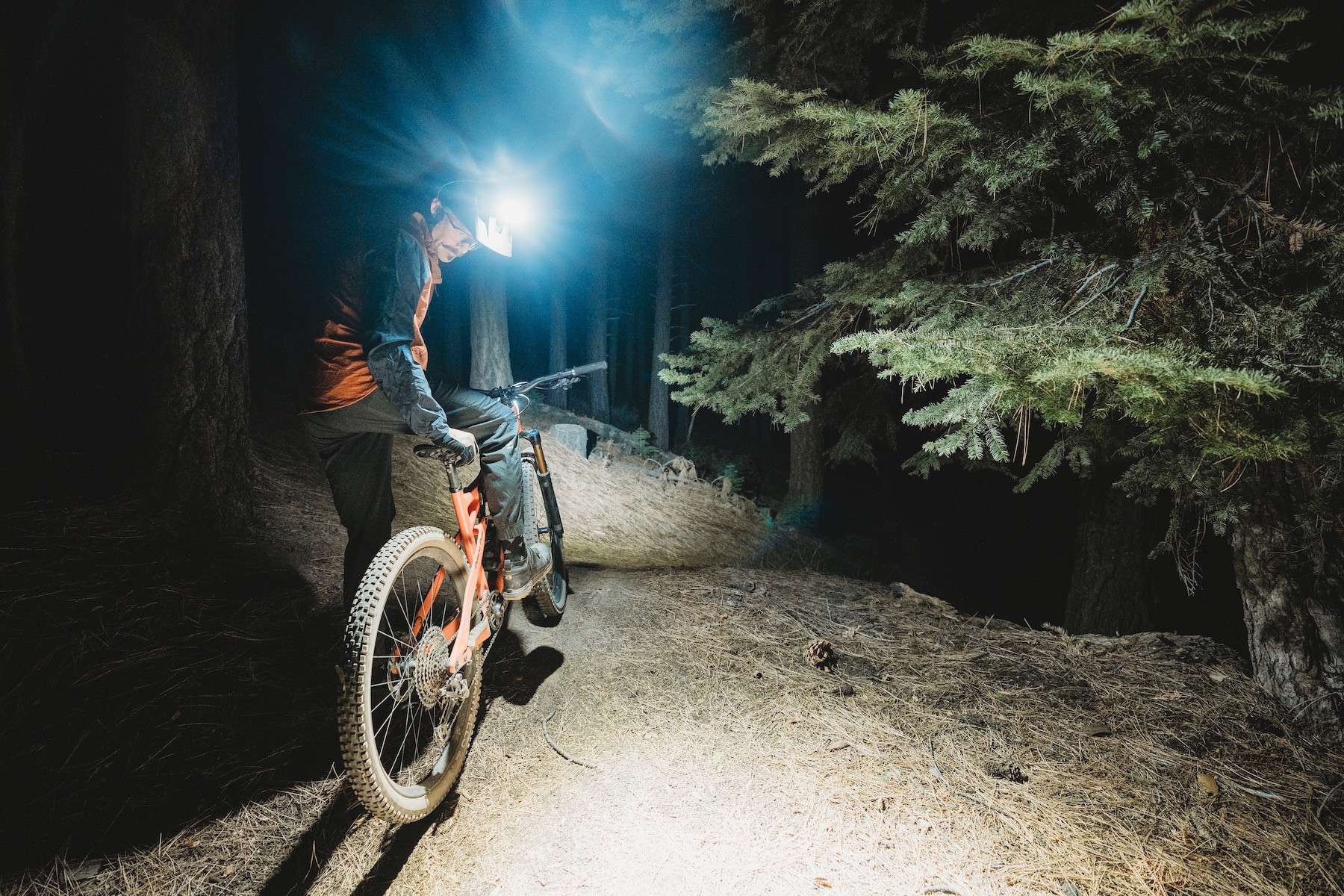 Riding with Knog Blinder X 1800 and 2300 mountain bike lights at night, showcasing balanced beam pattern
Riding with Knog Blinder X 1800 and 2300 mountain bike lights at night, showcasing balanced beam pattern